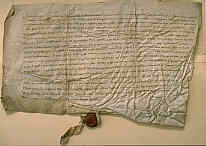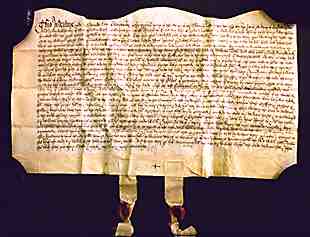 |
| Dealing With Medieval Documents |
| The concept of medieval manuscripts is tied firmly in the minds of some with beautiful illuminated manuscript books. We all love them, but a great deal of historical information is to be gained from the study of what might be considered a humbler class of manuscript from the aesthetic point of view, legal documents. Traditionally, the study of manuscript codices and documents has fallen to two different classes of experts. Even the terminology can be different. The study of the handwriting of manuscript codices is called paleography, while the study of the form and writing of documents has been called diplomatic. Literary experts, philosophers and theologians study books; historians and lawyers study documents. The process of reading both classes of manuscript is really not so different, but there are some particular tricks of the trade in finding information from documents. There are many reasons for wanting to investigate medieval documents, from tracing your own family history to researching a medieval historical theme to just wanting to find out what a piece of parchment that has found its way into your possession is about. |
 |
A 15th century charter, formerly in a private family collection. |
| The investigation of medieval documents might be approached from two different directions. On the one hand, a particular document might be the focus and the researcher may be trying to find out about it and where it fits into a context. On the other hand, the researcher may be trying to investigate a particular problem and be trying to locate documentary material as evidence. There are some issues in common to both approaches and some particular to each. The matter of reading the handwriting of a document, and of identifying just what kind of document it is, has been covered in other parts of this website and I do not intend to repeat them here. |
 |
Petition and endorsement of 1445 (London, National Archives E.28/74/52), by permission of the National Archives. |
| An important issue is that one single document will rarely give you the whole story about any matter, as it is likely to represent just one link in the chain of process that has occurred. The example above is a petition to the king from the abbess of Barking requesting a grant of two tuns of wine annually. A petition is one means of initiating a process. In this case a royal official has endorsed the document at the bottom right with the actions to be taken. Somewhere there was probably a whole chain of communication involving warrants from the signet to the privy seal, thence to the great seal, a writ to the exchequer and presumably, at some point, a communication to a wine merchant, not to mention the reverse communications acknowledging and reporting back. With a bit of luck, something of the whole affair may have been recorded for posterity on one of the rolls of the chancery or exchequer, or perhaps not. Bits and pieces like warrants and writs may have floated off over the centuries. This particular document is from the English public records, now housed in the National Archives in London. However, back in the 1830s in the Public Record Office the chains of communication relating to particular cases were broken up and the documents filed according to their class: petitions, warrants, writs, charters, letters patent etc. I guess it seemed like a good idea at the time. |
| Similar things may apply to an old family document preserved in isolation, a document located in a public archive by some sort of search procedure, or something old and interesting acquired in the marketplace. You may toil and slave over transcribing and translating it, only to discover that it does not tell you very much if the processes preliminary to the issue of the document and the consequences of what happened afterward are lost. There is nothing so annoying as finding that a document refers to matters in a schedule attached, and there isn't one. |
 |
Royal writ of 1328 (Westminster Abbey. Muniments. Coronation No.II). |
| This is one of my favourites and if you are an assiduous user of this website you have probably seen it elsewhere. A process could also be initiated by writ. Basically, a process starts by petition if somebody asks the king for something, but it starts by writ if the king decides to demand something of somebody. In this case, Edward III demanded by writ under the privy seal that the sheriffs of London arrange to return to Scotland the coronation stone of the Scottish kings which his grandfather had nicked and brought to London in the course of subduing those obstreperous northern chaps. It does not say why he wanted it returned. They did not return it and it stayed in London until 1996. Somewhere there must have been a chain of communication about this matter, but this lone document leaves more out than it tells us. |
| The various documents relating to any particular process or transaction may have ended up in different places. The example at right is an indenture, which was produced in duplicate, separated with a wavy cut, and each party to the agreement took one copy. They would remain in the possession of the interested parties until such time as they were no longer interested, or passed down through their families, ending up almost anywhere. At least in this kind of case we know that the two documents were identical. However, the formal archiving of such material could be something of an erratic process, especially the further back you go in time. |
|
Indenture of 1546, Nottinghamshire Archives DDFJ 7/80/11, by permission of Nottinghamshire Archives. |
| The documents recording orders or instructions from the emperor Charlemagne, known as capitularies, are known only from later copies. It has been suggested that these were actually delivered orally and notated down by officials in the places where they were delivered, copied on periodically for reference. The records of the kings of England and France were originally lugged about with the court, and many got lost on the way. The process of transcribing financial records, charters, letters patent and letters close on to rolls kept by the chancery in some sort of permanent abode was introduced only gradually from around the 12th century on, the records becoming more extensive as time went on. These rolls do not represent a complete record even for the period when they were in use. Citizens who had been granted privileges from the king by letters patent could have them recorded on the rolls if they paid for them, otherwise they were not. A reasonable presumption might be that the rolls were biased towards results where people got what they wanted, rather than those where they were refused by the king. Must be a research project in there somewhere. |
| Simply finding documents is an art in itself, although modern technology is steadily making it easier as online catalogues become more available, comprehensive and user friendly. The easiest type of search to do is using the name of a person or place, although it is necessary to try all the possible variants of spelling. Full text searches of documents are rarely possible, so if you are attempting to address a theme, whether it be the cost of barley through the centuries or the development of the shoemaking trade, it can be difficult to locate the items you want unless you can find your way to thematic collections such as guild records, monastic collections, manorial collections or whatever. I once attempted a quick and dirty search of wills, published in full text and available online, for references to books. I found some, but also found bokes, bookis and numerous other spelling variants, not to mention different types of books specified by name; and psalter can be spelled psautier, a porte is a portable breviary and in general all manner of antiquated spellings and terms abound. Simple word search is rarely an option. The cost of downloading images even from such advanced sites as the National Archives in London becomes prohibitive when you have to pay to download an image before you can look at it, but do not know whether it is going to be of the slightest use until you have seen it. Some kinds of searches, and even the research itself, can be conducted online; others you just have to sit at a desk in an archive and shuffle through piles of grubby parchment sitting in boxes. Despair? Not yet. There is hope. |
|
 Why Read It?
Why Read It? |
|
 |
 |
 |
 |



